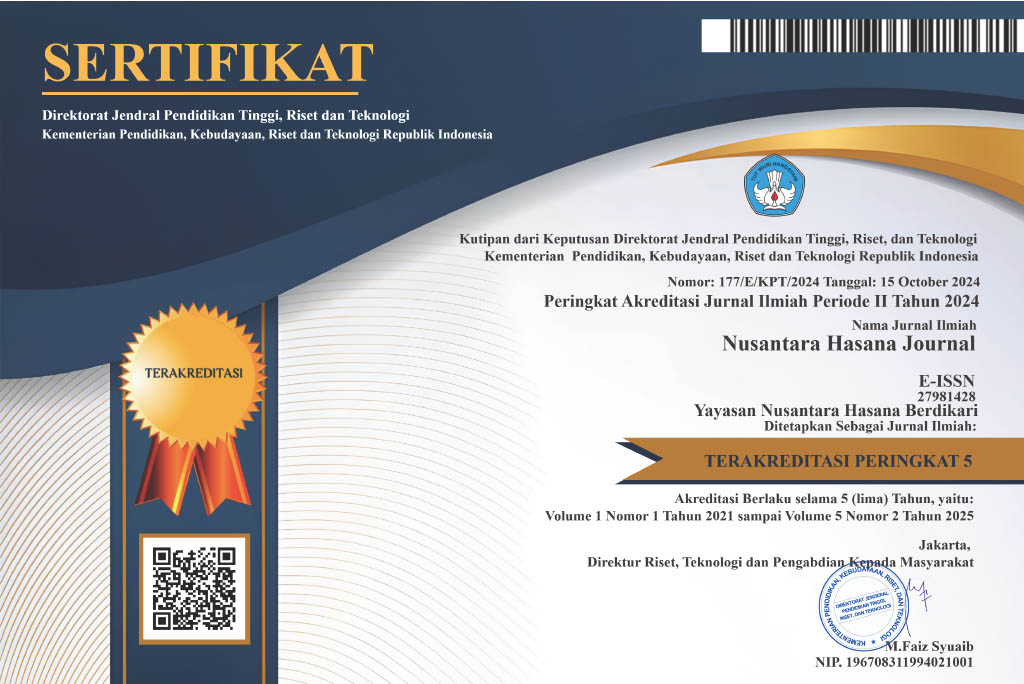HUBUNGAN FAKOEMULSIFIKASI DENGAN KEJADIAN SINDROMA MATA KERING DI RSKM PADANG EYE CENTER TAHUN 2021
DOI:
https://doi.org/10.59003/nhj.v3i4.1283Keywords:
age, gender, occupation, duration, dry eye syndromeAbstract
Dry eye syndrome is a one of disorders of the tear film caused by decreased tear production and increased tear evaporation, resulting in uncomfortable eye symptoms such as irritation, soreness, watery, sandy, sticky, itchy, red, feel sleepy, easily tired as a result there is a decrease in visual acuity when corneal epithelial damage has occurred and even perforation. This study used primary data using a questionnaire. The sample was selected by means of probability, namely consecutive sampling. The target population was cataract sufferers at RSKM Padang Eye Center who underwent cataract surgery using the phacoemulsification technique who experienced dry eye syndrome. The type of research used is analytic observation. The number of samples obtained as many as 96 people. The results of data analysis obtained that the most age was the elderly, namely 73 people (76.0%), the most gender was female, namely 59 people (61.5%), the most work was indoor, namely 54 people (56.3%), post phacoemulsification duration was the same amount between 7 days, 30 days and 3 months, namely 32 people (33.3%). With dry eye syndrome after cataract surgery at RSKM Padang Eye Center in 2021 (p=0.004). Most age are the elderly, the most gender are female, mostly work indoor, the duration of post phacoemulsification is the same between 7 days, 30 days and 3 months, most severe post-catarrhal dry eye syndrome is severe and there is a relationship between the duration of postphacoemulsification with dry eye syndrome after cataract surgery at RSKM Padang Eye Center in 2021.
Downloads
References
Asyari. (2007). Dry eye sindromae (Sindroma Mata Kering). Dexa Media, 20 (4): 162-167.
Cho, Y. K., & Kim, M. S. (2009). Dry eye after cataract surgery and associated intraoperative risk factors.Korean Journal of Ophthalmology, 23 (2): 65-73.
Depkes RI. (2015). Katarak Dapat Disembuhkan.
Steinert, R. F. (2010). Cataract Surgery. Saunders Elsevier.
Asbell, P. A., & Lemp, M. A. (2011). Dry Eye Disease: The Clinician’s Guide to Diagnosis and Treatment.
Swarjana, K. (2015). Metodologi Penelitian Kesehatan: Edisi Revisi. Yogyakarta: Andi.
WHO. (2010). Visual Impairment and Blindness 2010.
Setyowati N & Suryandari D. (2020). Gambaran Tajam Penglihatan Post Operasi Katarak Di Rumah Sakit Mata Solo. Surakarta: Program Studi Sarjana Keperawatan Dan Profesi Ners Universitas Kusuma Husada.
Bokka VS, Mallampalli VB. 2016). A clinical study of complications of cataract surgery SICS v.s ECCE. J Evid Based Med Healthc., 33 (3): 1565-1568.
Miranty A.H., Eso, A., & Wicaksono S. (2016). Analisis Faktor Risiko yang Berhubungan dengan Kejadian Katarak Senilis di RSU Bahteramas Tahun 2016. Jurnal Medula, 3 (2): 2443.
Ginting PO. (2017). Gambaran Kualitas Hidup Pada Pasien Penderita sindroma Mata Kering Di Rsud Dr. Pirngadi Medan. Universitas Sumatera Utara Medan.
Li M, Gong L, J W. (2012). Assessment of Vision-Related Quality of Life in dry eye Patients. Cornea, 53: 5724-5725.
Chaironika N. (2011). Insidensi dan Derajat dry eye pada Menopause di RSU. H. Adam Malik Medan.
Suryani. (2018). Perbandingan dry eye Setelah Operasi Fakoemulsifikasi Antara Letak Insisi Temporal Dengan Letak Insisi Superior. Universitas Hasanuddin Makassar.
Liu YC. (2017). Seminar Cataracts. The Lancet Journals, 390: 600-612.
Remington. (2012). Cornea and sclera. Clinical Anatomy and Physiology of the Visual System.
Skuta. (2011). Tear Film. BCSC Fundamentals and Prinsiples of Ophthalmology. Singapore: American Academy of Ophthalmology.
Kaur. (2019). Ocular preservatives: associated risks and newer options. Cutan Ocul Toxicol.
Philo SM. (2017). Perbandingan sindroma Mata Kering Pre Dan Post-Operasi Katarak Senilis Dengan Teknik Fakoemulsifikasi Di Rumah Sakit PHC Surabaya. Surabaya: Universitas Katolik Widya Mandala.
Cetinkaya, S., Mestan, E., Acir, N.O. (2015). The course of dry eye after phacoemulsification surgery. BMC Ophtalmology, 15: 68.
Kasetsuwan, N., Satitpitakul, V., Changul ,T., Jariyakosul, S. (2013). Incidence and pattern of dry eye after cataract surgery. PLos One, 8: 1-6.
Sarungallo, F., Syawal, S.R., Hamzah. (2016). Dry eye Pasca Operasi Katarak Dengan Teknik Fakoemulsifikasi. Tesis. Makassar: Program Pasca Sarjana Fakultas Kedokteran Universitas Hasanuddin.
Khanal. (2008). Changes in corneal sensitivity and tear physiology after phacoemulsification. Ophthalmic Physiol Opt.
Asiedu K. (2017). Rasch Analysis of the Standard Patient Evaluation of Eye Dryness Questionnaire. Eye & Contact Lens. Science & Clinical Practice, 43 (6): 394-398.
Sullivan, BD. (2012). Clinical Ultility of Objective Test for Dry Eye Disease: Variability Over Time and Implications for Clinical Trials and Disease Management. Cornea.
Nichols KK. (2004). The Lack of Association between Signs and Symptoms in Patients with Dry Eye Disease.
Downloads
Published
How to Cite
Issue
Section
License
Copyright (c) 2023 Raihana Rustam

This work is licensed under a Creative Commons Attribution-NonCommercial-ShareAlike 4.0 International License.
NHJ is licensed under a Creative Commons Attribution-NonCommercial-ShareAlike 4.0 International License.
Articles in this journal are Open Access articles published under the Creative Commons CC BY-NC-SA License This license permits use, distribution and reproduction in any medium for non-commercial purposes only, provided the original work and source is properly cited.
Any derivative of the original must be distributed under the same license as the original.
























